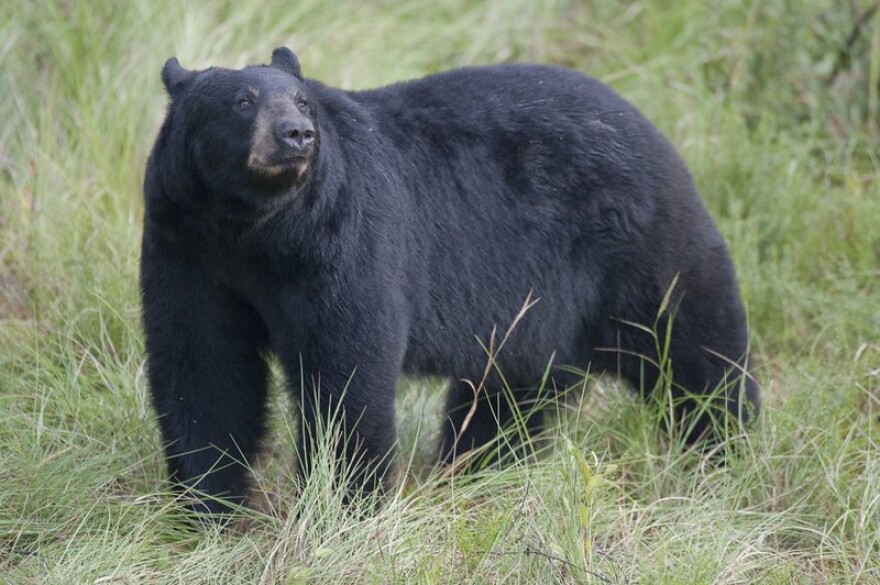Ways to manage Florida’s black bear population are outlined in the draft of an updated 10-year plan that’s out this week.
Florida’s bear population is estimated at 4,000; and the goal is to keep that number stable, according to Dave Telesco at the Florida Fish and Wildlife Conservation Commission. To do that, they have to keep one step ahead – especially this time of year.
“The season starts in September regardless of how our weather is, and once we get a little bit of cool weather, that kicks them into high gear,” said Telesco. “Bears go from a 5,000- calorie diet a day to 20,000 calories a day. They’re going to be active here all the way into December.”
Florida black bears typically range from 250 to 450 pounds for males and 125 to 250 pounds for females. They don't have to hibernate to avoid the cold, but they do go into a lethargic state because there is less food in the winter.
Meanwhile, FWC is working on an update of its Bear Management Program ahead of schedule.
“Basically, the Bear Management Plan is like any other management plan, where FWC has a regular update period; and normally, it’s every 10 years,” Telesco said. “But our commissioners asked us to bring it back a couple of early, just because we’ve done so much research and have a lot of things to put in there. That’s why we’re bringing it to them in December of this year.”
The most recent bear estimates replace those from 2002, and show that the statewide population has grown by more than 50 percent. Telesco says the actual number of bears in an area depends on which area.
“Some areas don’t have many bears at all; other areas have a lot,” said Telesco. “But they’re very healthy, they’re doing well in most parts of the state, and so that’s something that makes us in a position where we need to talk about what areas are doing well, and what do we need to do with that population versus another.”
Northwest Florida is considered to have one of the smaller bear populations in Florida – most of them around Eglin Air Force Base. But Telesco says while there’s an increase from 2002, the lesson here is not numbers, but rather how they interact with people.
>> See FWC's Living with Bears article
“While Eglin doesn’t have the largest population, they’re generating almost the most calls,” Telesco said. “I think Santa Rosa County just got beat out by Collier County in 2018. But for a couple of years straight Santa Rosa County had the most calls. And it’s because when a bear comes out of the woods, it’s kind of stepping into suburban and urban areas.

“One bear can generate a whole lot of calls.”
Some of the management options being studied for the plan upgrade are divided into four conservation focus areas: population management; habitat conservation, human-bear conflict management; and education outreach.
“And it’s actually broken down by bear management unit; if you live in the western Panhandle you can look at the West Panhandle bear management unit,” said Telesco. “And it will talk very specifically about how the bear population is doing; what are the options that we have for those different areas, how we can look at the threats that are facing that population, and that sort of thing.”
The public can help by taking measures to “bear-proof” their homes and property, starting with keeping the garbage locked up.
“You’ve got to keep your trash secure until the morning of pickup,” said Telesco. “That way, we’re not inviting bears to come into the neighborhood and get at garbage – which is a very easy meal for them. It takes a lot less effort, than to go pick up acorns or berries in the woods.”
FWC allowed a regulated hunting period for bears a couple of years go, and that remains one of the proposals in what Telesco calls a “suite of options” for the management plan upgrade – which also includes a continuation of the “Bear Wise” plan.
“It can be multiple options are used, [or] none of them are used; but at some point some of those options need to be looked at in moving forward,” said Telesco. “Because basically we’ve got a growing bear population, and a growing people population. The BearWise idea is – keep things secure so the bears aren’t invited in; when you see them, scare them off, and then you know who to call.”
People across the state are invited to provide feedback on the plan by completing an online survey at www.MyFWC.com/Bear between now and Nov. 6. In addition, the FWC is holding two webinars on October 24 and 29.
As mentioned, the FWC Commission will receive the new plan at its December meeting in Panama City.

